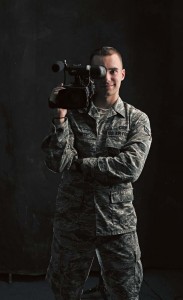Broadcast journalism is a tool used to inform the public on who, what, when, where, why and how the members of the Air Force complete the mission.
On Ramstein, Airman 1st Class Thomas Smith is one of the broadcasters who bridge the gap between the Air Force and the world. Working in public affairs affords Airmen an opportunity to highlight fellow wingmen and what they do on a day-to-day basis. Yesterday, I caught up with Smith and flipped the script, giving him a moment in the spotlight to tell his story.
Q: What are your duties as a broadcaster?
A: As a broadcaster, it is my job to broadcast video productions, such as documentaries, news stories and training videos.

March 2011.
Q: Do you constantly find yourself learning new things about your career field?
A: The broadcast career field is always changing, so we’re always learning something new. There will always be new cameras, new tools and equipment, and different ways to tell the Airman’s story.
Q: What is your favorite part about being a broadcaster?
A: My favorite thing about my job is telling the Air Force story — really, being able to highlight Airmen. I get to broadcast to the world the work these Airmen are doing.
Q: What is the most challenging part about broadcasting?
A: The hardest part about broadcasting would definitely be finding the best way to tell the story and get the message across. Sometimes it’s hard to portray to the public exactly what you want.
Q: Do you have any broadcasting-related aspirations beyond your military career? How long have you been interested in broadcasting?
A: Since I was 10 years old, I’ve been interested in broadcasting. I started with my dad’s camera that had a video function on it, and I would start making home videos with my friends. Then, once I joined the military, I found this job and said, “Hey, that’s perfect.” I do plan on becoming a civilian broadcaster after I leave the Air Force.
Q: If you could use any equipment in the world to work with, what would it be and why?
A: If I could use any equipment in the world, it would be the equipment I work with now. Technology is always changing. There will always be more or better equipment out there, but the equipment I work with today helps me produce high-quality work.
Q: When people ask you about broadcasting, is there a story that you’ve covered that you’re constantly reminded of? Why?
A: As I’ve come along, I’ve realized that every story is a little different, and it’s a really cool thing to see how after every story, I’ll grow as a broadcaster.
Q: Are there any limiting factors that keep you from adding your own creative aspect or are you allowed to be as creative as possible while broadcasting?
A: Being an Air Force broadcaster, you have your limitations. The work you produce has to be professional and maintain Air Force standards. I love the challenge of finding new, creative ways to showcase the Air Force.
Q: How essential do you feel your job is in helping the Air Force complete its mission?
A: I believe my job is essential to the mission because without us — public affairs — people wouldn’t be informed as to what is going on. It’s important to get our commander’s intent out as well as let civilians know what we’re doing here — assuring them their tax dollars are being put to good use. I think the Air Force just runs smoother when everyone is well informed and aware of the operations at hand.
Q: Is there anything you would like to add about broadcasting that you think the public would like to know?
A: I think broadcasting is one of the best jobs you could have in the Air Force, and I love it. I love every day of it.


